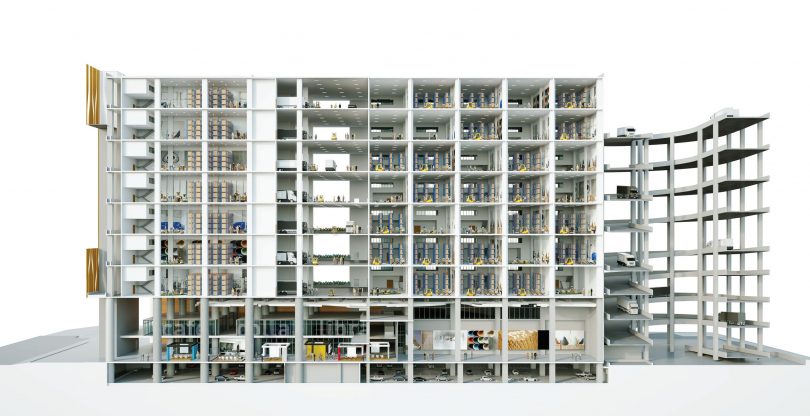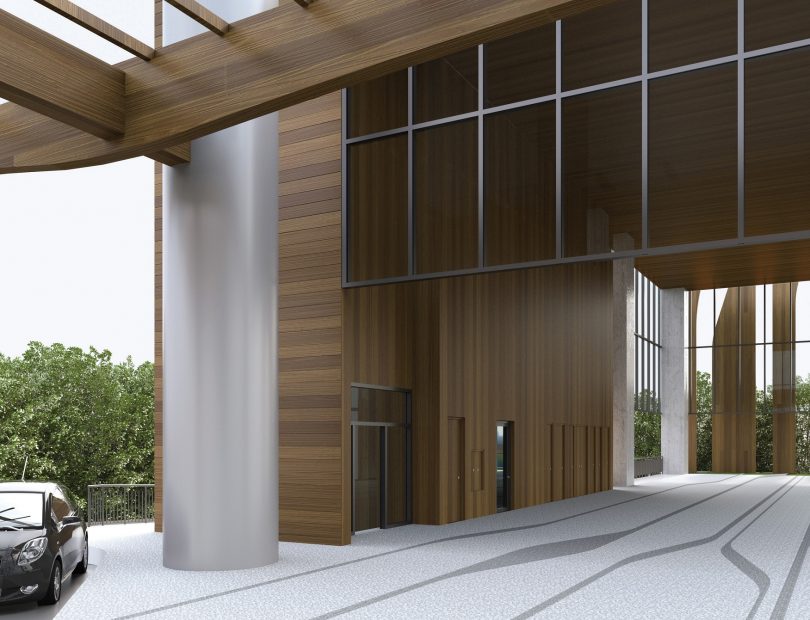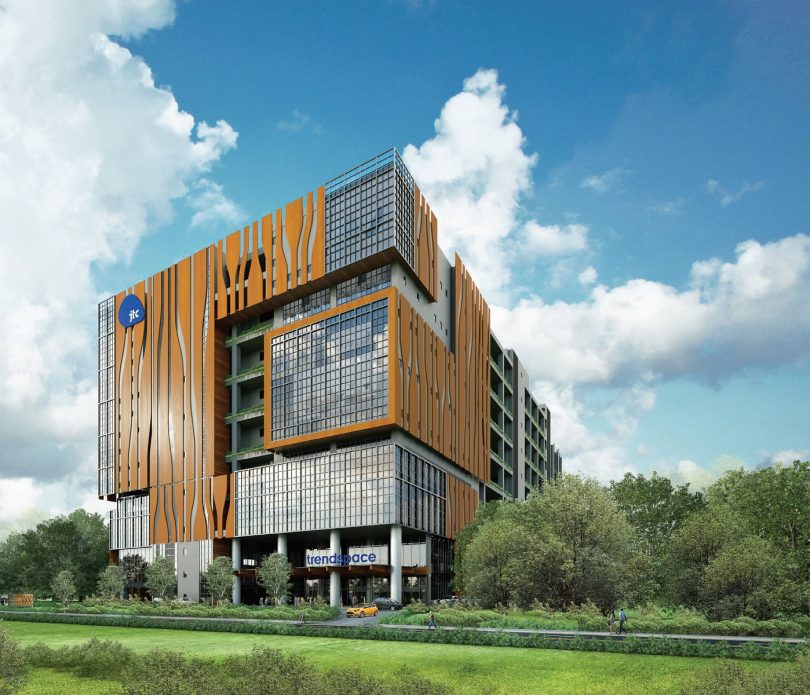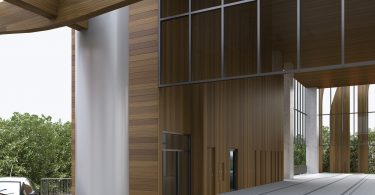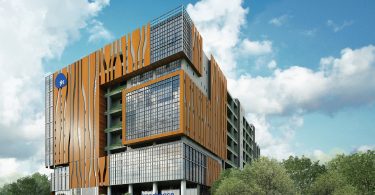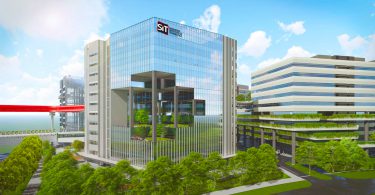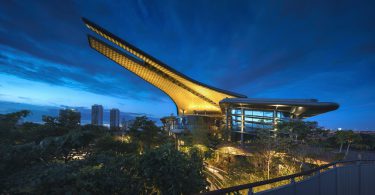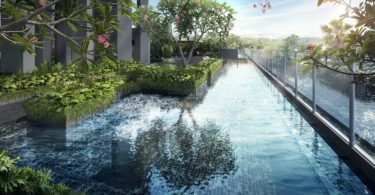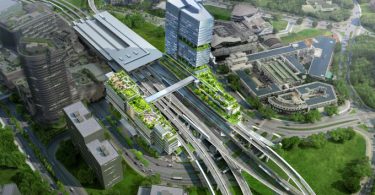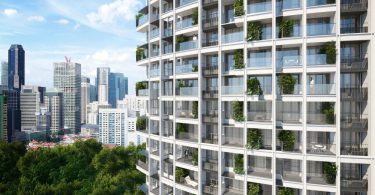![]()
trendSpace is Singapore’s first high-rise multi-tenant development that will cluster furniture and furniture-related companies under one roof. It is set to house a thriving ecosystem of furniture industry players in areas such as manufacturing, interior fit-out, design and distribution. The clustering of furniture players at the development will enable companies to share resources and foster synergies and collaborations.
Extensive research and surveys were completed by engaging the furniture industry through the Singapore Furniture Industries Council (SFIC) to learn about the current industry practice, its advantages and disadvantages, and to understand the needs of its users that are currently lacking in their existing spaces. Through this research, the design brief took form in an effort to improve the spaces for the furniture industry.
The development comprises large modular factory units of about 500 to 1,000 square metres, with the flexibility of expanding the space to larger floor plates of up to 3,000 square metres.
The development will also feature export showrooms, a training institute, co-working spaces and an atrium space for industry-related events and exhibitions as part of SFIC’s Experience Centre.
LOCATION
The project is located at 5 Sungei Kadut Street 2. Sungei Kadut is a region in Singapore that is well-known as an industrial estate for furniture-related companies. Nestled in the heart of Sungei Kadut, trendSpace will play an important role in the transformation of Singapore’s furniture industry and Sungei Kadut. As companies in the Sungei Kadut estate move into trendSpace, JTC will have the opportunity to rejuvenate the estate by enhancing its infrastructure and connectivity, thus making it a more conducive and attractive location for businesses.
Although the furniture industry in Singapore remains vibrant, a call for transformation is echoed in this sector as part of the country’s efforts towards a smarter nation. The concept of grouping and bringing together furniture-related stakeholders at one location will allow furniture companies to benefit from resource-sharing arrangements as well as potential synergies and collaborations. Creating such an ecosystem will help to convince older stakeholders, who may not be as keen to change or embark on new technologies, business models and innovations.
Because many furniture-related companies are all located in Sungei Kadut, the potential to share resources, reduce wastage and value-add towards one another’s business is huge. The future of this industry should be a workflow chain of production and services that can synergise through colocation and be more environmentally sustainable and conscious of the impact of their business on the natural environment.
MATERIALS
This project utilises a number of innovative approaches to increase productivity and efficiency of construction. Precast structures that include columns, beams, slabs and walls that are cast in factories off-site are used. A special ‘lotus root’ detail to connect the beam to the column is designed into the assembly of precast structural elements on-site. Precast columns are also erected without propping to minimise site obstruction and efficiency. The project also makes use of Prefabricated Prefinished Volumetric Construction (PPVC) toilets that are preformed and prefinished in the factories to increase construction productivity.
With a large proportion of surfaces being precast and precast yard being a controlled environment, further initiatives to reduce laborious work and productivity are made possible by specifying off-form finishing at ceiling soffits. As for the façade treatment, it consists partly of curtain wall and composite panels. These are designed with reduction of wastage in mind, avoiding small pieces that would have taken more time to install. The façade panels are also specially selected because they are close to maintenance-free, durable and weatherproof.
With the support of JTC as developer of this project, investment was also made to utilise available technology and BIM development to answer the call of digital transformation for the building industry. This project implemented Virtual Design and Construction (VDC) coordination that has all discipline of consultancy to combine their BIM model and building data into a single coordinated model further developed by the main contractor. With such a model, the construction and detailing can be simulated to ‘rehearse’ the construction of the building.
OVERCOMING CONSTRAINTS
One of the early considerations during the design phase was to mitigate and separate the primary operational heavy vehicular movement from the passenger vehicles and pedestrians that visit this development. Intentionally, the development has two vehicle entrances created, one that leads to the heavy vehicle ramp-up to the typical factory floors and one that leads to the basement car park. Further from this, attention was also given to the experience of people working in this building as well as customers that visit the businesses in this building. Customers and visitors can take lifts that lead to executive corridors that have planters of greenery along the corridor edge segregated from the operation back-of-house of the factories. Practical mezzanine floors are inserted in each factory to free up the operation floor and create flexibility for offices in the mezzanine. Staff and business operators can also access the rooftop garden that is designed for communal engagement and recreational programmes.
GREEN FEATURES
This project has obtained Green Mark Platinum certification from the Building and Construction Authority (BCA). On top of chiller efficiency, Green label products, energy-saving fittings and natural/mechanical ventilation efficiency, the roof is also prepared and ready to receive solar photovoltaic panels. Future-proofing and maintenance considerations were also incorporated into the design. At the rooftop, Building Maintenance Units (BMU) and permanent brackets for installation of Davit Arm rigs are provided.
The project will rise above many of the existing low-rise and under-intensified land in the area. With the injection of this project and the improvement of the local civil infrastructure and connectivity of Sungei Kadut to other parts of Singapore, this project hopes to be a flagship for industrial change and refresh this industrial estate by bringing industrial partners together.
PROJECT DATA
Project Name: trendSpace
Location: 5 Sungei Kadut Street 2, Singapore
Status of Construction: Building superstructure
Expected Completion: December 2018
Site Area: 20,906.83 square metres
Gross Floor Area: 68,421.84 square metres
Building Height: 8 storeys; 75 metres
Number of Units
63 units with 60-square-metre mezzanine office each
21 units: 1,000 square metres each
42 units: 500 square metres each
Developer: JTC Corporation
Architecture Firm: ID Architects Pte Ltd
Principal Architect: Jin Sung (QP)
Civil & Structural Engineer: Arup Singapore Pte Ltd
Building Services Engineer: Arup Singapore Pte Ltd
Quantity Surveyor: Arcadis Singapore Pte Ltd
Landscape Architect: Martin Lee Designs
Green Building Consultant: Arup Singapore Pte Ltd
Main Contractor: Straits Construction Singapore Pte Ltd
Images: JTC; ID Architects Pte Ltd

 Malaysia
Malaysia Hong Kong
Hong Kong Indonesia
Indonesia Tiếng Việt
Tiếng Việt ประเทศไทย
ประเทศไทย


